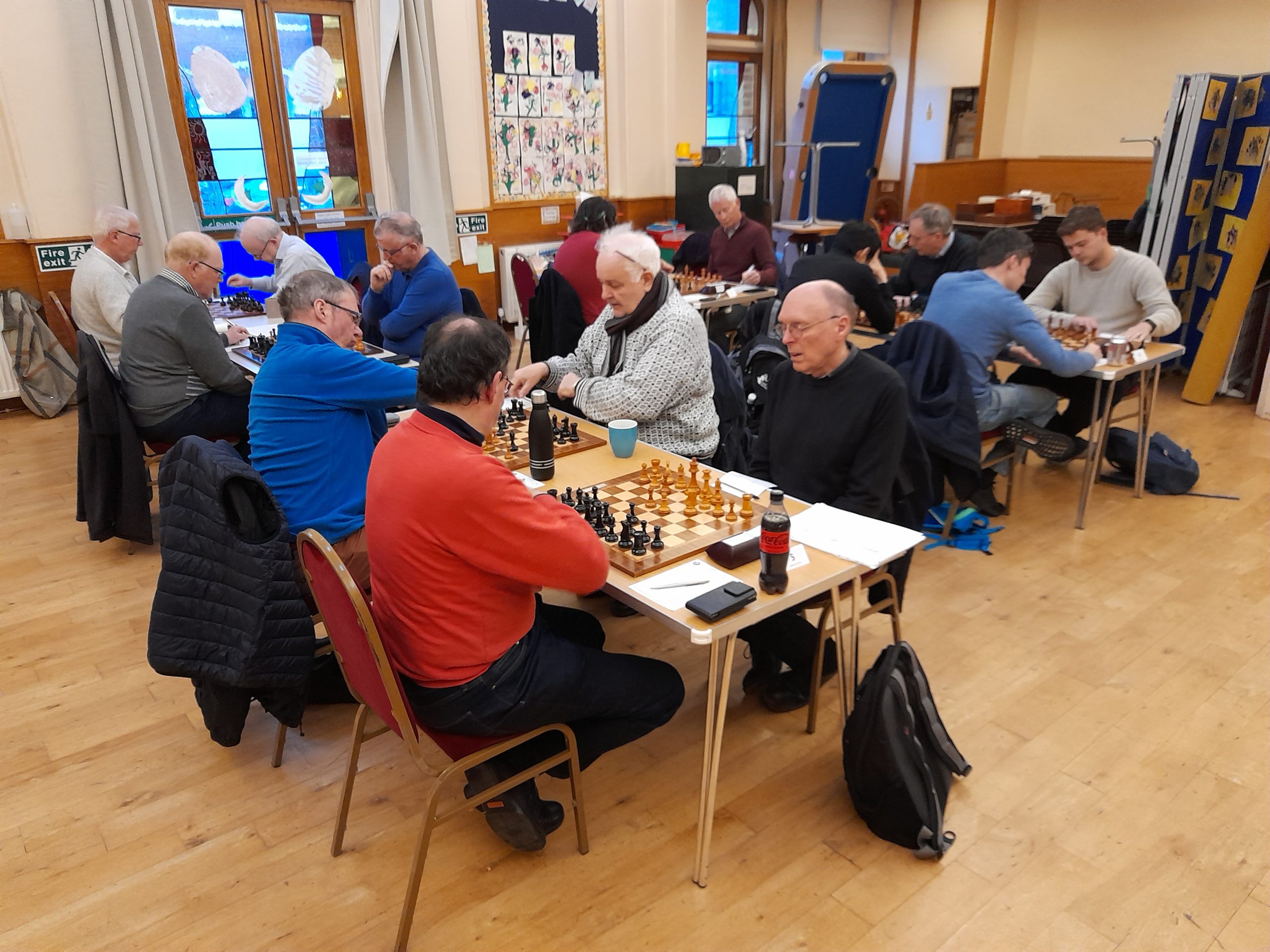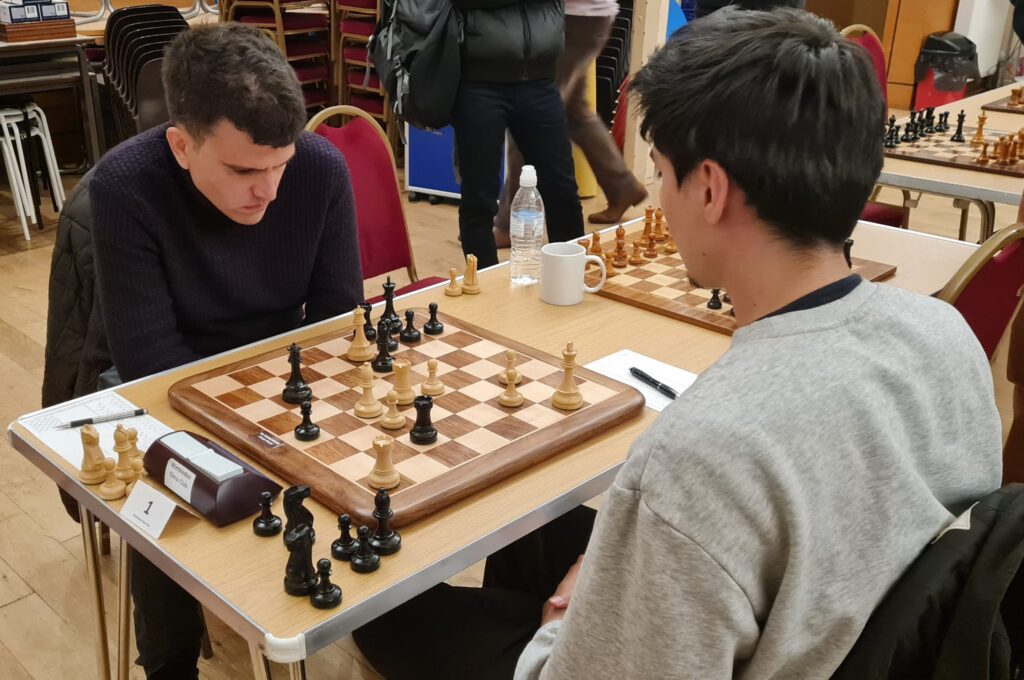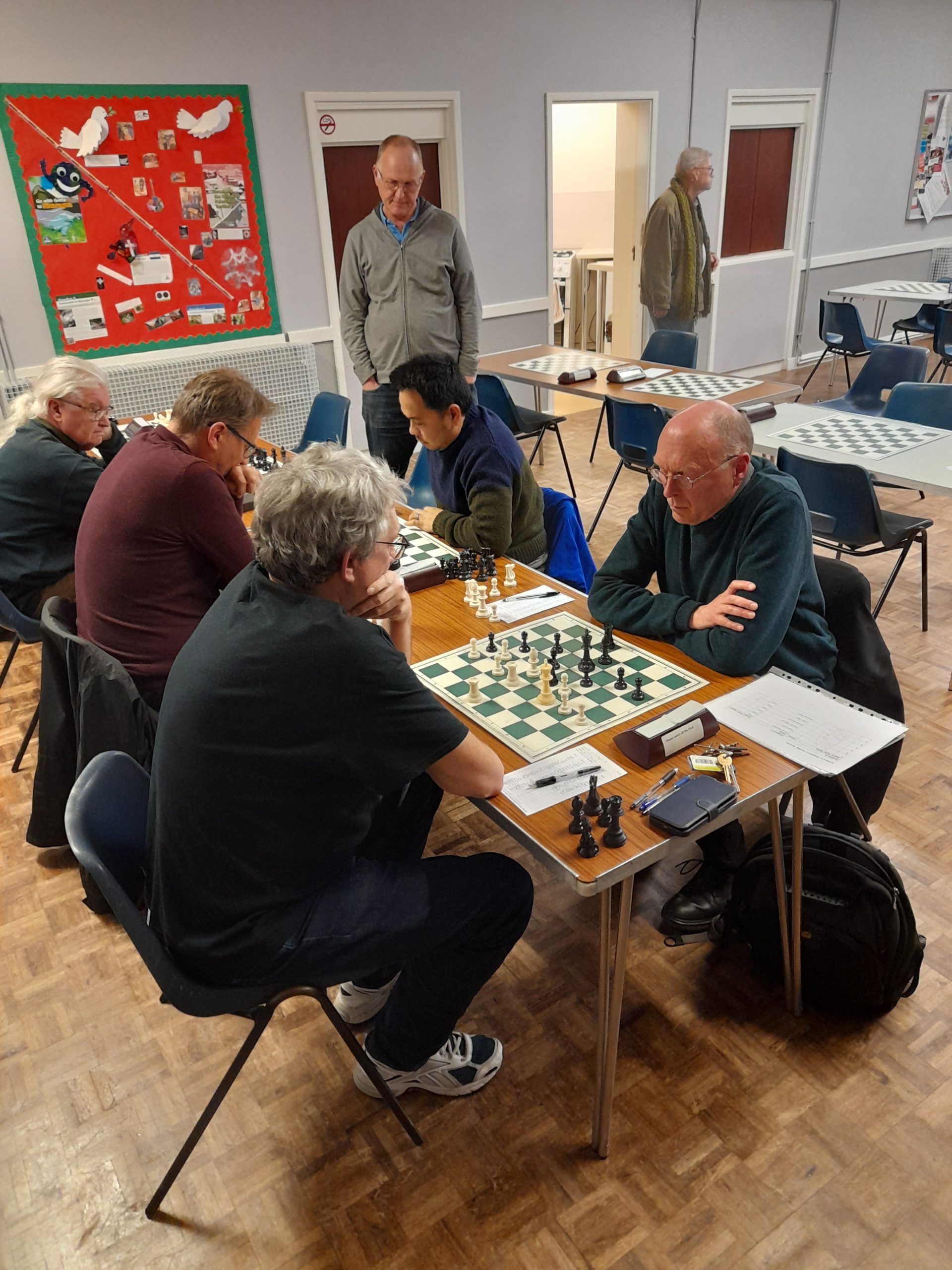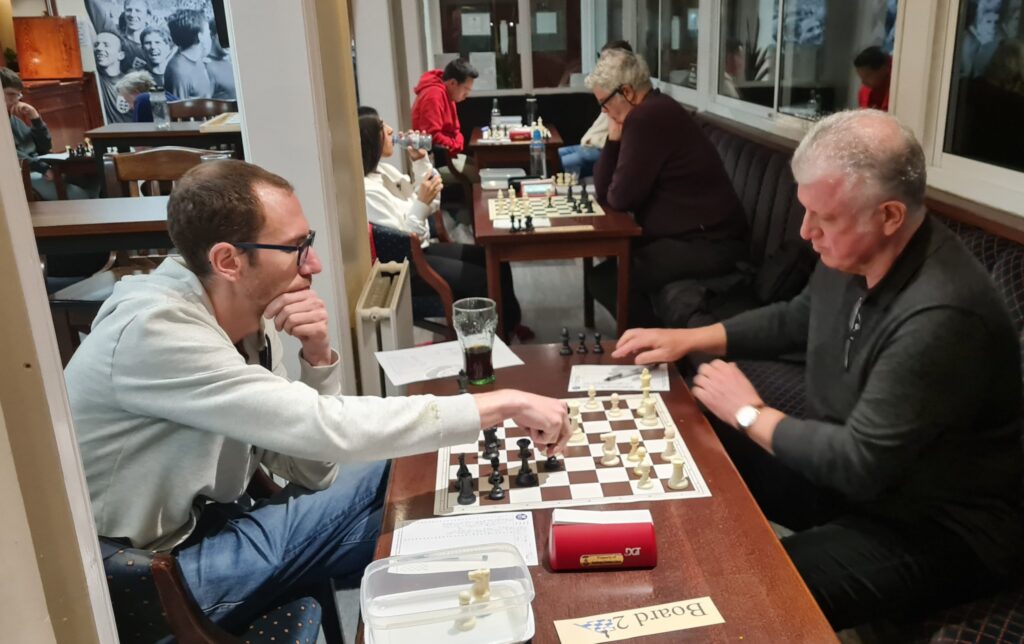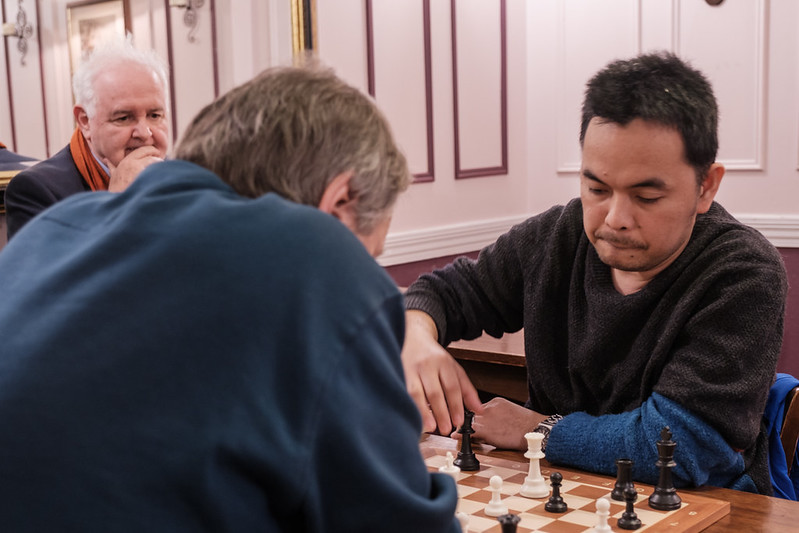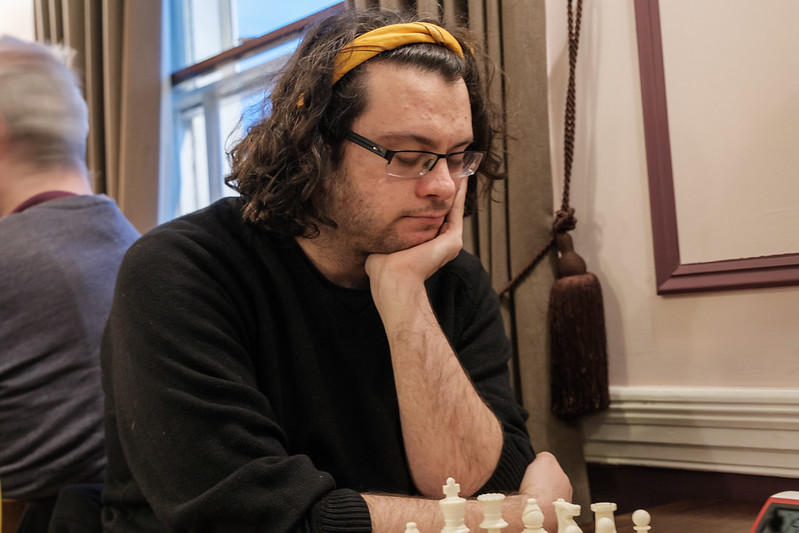Thames Valley League division 1 match played at Actonians Sports Club, Ealing on 24 April 2023
This was always going to be a difficult match, and so it proved. Kingston were missing some key players – this was a rare outing for the first team without the foundation stone of Maycock & Lalić – whereas Ealing had a very strong line-up. We were outrated by an average of 50 points a board, and such was the level of Kingston captain David Rowson’s desperation that he had called me up to play.
The tone was set in the board 4 encounter between Kingston stalwart Alan Scrimgour and strong junior Nishchal Thatte. In a French Winawer, the position quickly became complex, with White’s king uncastled and Black lining up its rooks on the kingside. Black appeared to be pressing, but the danger may have been more visual than real, and on move 24 peace was declared with a threefold repetition in this position:
“After Black closed the position with c4,” Alan explained later, “White has the chance to gain space on the kingside. Once Black castles queenside, White has to be careful in opening the position in front of his king. While I manoeuvred for the f5 break, Black reacted with a threat on the queenside that either won a pawn or forced a repetition.”
On board 2, David Rowson was up against Alan Perkins, an old adversary whose Fide rating of 2235 gives an idea of his strength. David played the King’s Indian Attack against Perkins’ Sicilian, and the critical position was reached on move 25:
Here the engine recommends 25. Nxd5, and David says he did consider that but was unconvinced, so played Rac1 to shore up the weak pawn on c3 instead. That gave him a rather passive game and a draw was agreed soon afterwards, with another repetition looming. A possible continuation if he had played 25. Nxd5 is 25…Nxd5 26. Nxc4 Qd8 27. Nd6 Bf7 28.Qc5 Nce7 29. c4 Rc7 30. Nxf7 Kxf7 31. Bxd5+ Nxd5 32. Qxd5+ Qxd5 33. cxd5 Rb4 34. d6 Rd7 35. d5 Rxd6. Quite a lot to calculate and, ironically, resolving into a rook endgame that may still be drawn. So 1-1, but Ealing may have felt the happier having secured draws with the black pieces in both games.
I had the third White, and could also do no better than draw. My opponent played a Scandinavian and equalised without too much trouble. When he exchanged queens, I assumed he was angling for a draw, but he turned down my offer – I was also outgraded and feeling the pressure in this rarefied atmosphere – and played on for another 50 moves, with much shuffling of rooks and bishop in what I felt was a fairly sterile position. For once, my analysis was vindicated, because after 70-odd (in my case very odd) moves, the rooks came off and a draw became a certainty.
There was a good deal more life in the clash on board 1 between Ealing FM Rick McMichael and Kingston’s budding FM Vladimir Li. McMichael opened with the Nimzowitsch-Larsen Attack, Vladimir had a small plus in the opening, but McMichael skilfully turned it round before losing his slight edge in this very double-edged position:
Here McMichael played the perfectly plausible Qa5, pinning (and you might think winning) the dangerous a-pawn. But Vladimir counters with 31…f5 and the bishop on g7 is now threatening to come to d4, winning back the exchange. McMichael guards the d-file with Rd1, but has overlooked that Bd4! can still be played because, if rook takes bishop, Black’s queen mates on c1 (with the rook on f2 unable to block because of the bishop on h3). The final moves were 33. Qxa4 Bxf2+ 34. Kxf2 Qxa4 when a draw – the fourth of the night – was agreed.
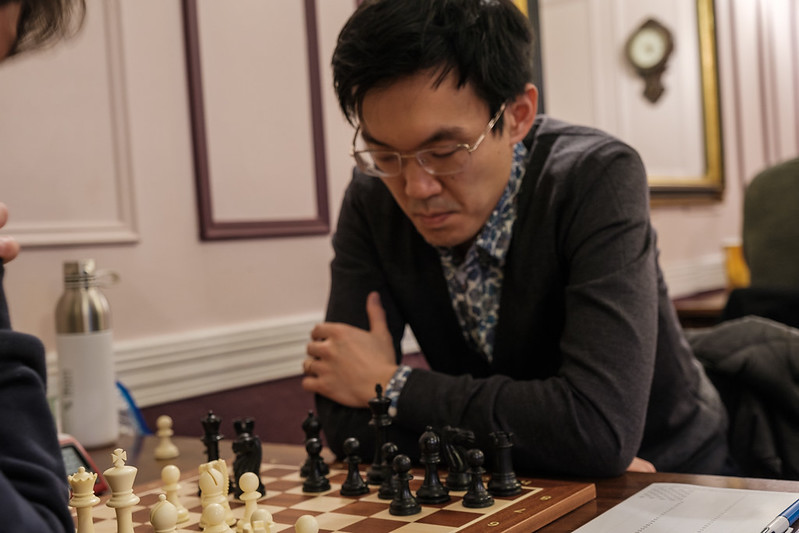
That left Peter Andrews and John Foley still playing. John, we felt, was doing well on board 3 against another FM, Andrew Harley, but Peter appeared to be in a spot of bother in this position:
White made an odd choice here, though, moving the menaced queen to c1 rather than a3 where it would have guarded the b4 pawn. Presumably he believed that doubling the pawns on the f-file would be adequate compensation, but it never thereafter gave Peter any alarms. He traded pieces and reached a rook endgame in which, if anything, he had a slight edge. With John up on board 3, Peter agreed a draw, and now it was left to the Kingston president to put the ball in the back of the net.
FM Andrew Harley played the Panov-Botvinnik Attack against John’s Caro-Kann, but John grabbed the initiative with a pawn sac and then offered another pawn to break up White’s pawn structure. They reached this position on move 24. The white king is looking somewhat exposed, especially if the black queen and bishop can form a battery on the long diagonal.
In the game, John retreated his queen to d8. White exchanged queens to eliminate any potential mating attacks and offered a draw, which John declined. Thereafter, John went about patiently improving the position of his minor pieces – his endgame play this season has been exemplary. Within a few moves he had achieved this position in which the white rooks are rendered passive and the white pawns immobile.
Harley had the additional problem of being in time trouble, but with all apparently lost still had the gumption to try a neat trick with 71. Rb6+:
Black, who was also short of time, has to be careful how to react here, because 71…Bxb6?? would produce stalemate. How satisfying that would have been for White, and how heart-breaking for Kingston. John, though, was alert to the danger and calmly played Nb5, blocking the check while giving White’s king a flight square on e2. Now Harley called it a day, and Kingston had secured a victory against the odds.
After the game, Peter Andrews said that in his chess career he had never played a justified under-promotion – the sort of move that might appear in print. John saw that under-promoting to a rook would have avoided the stalemate but had the knight retreat up his sleeve – being professional rather than seeking puzzle glory.
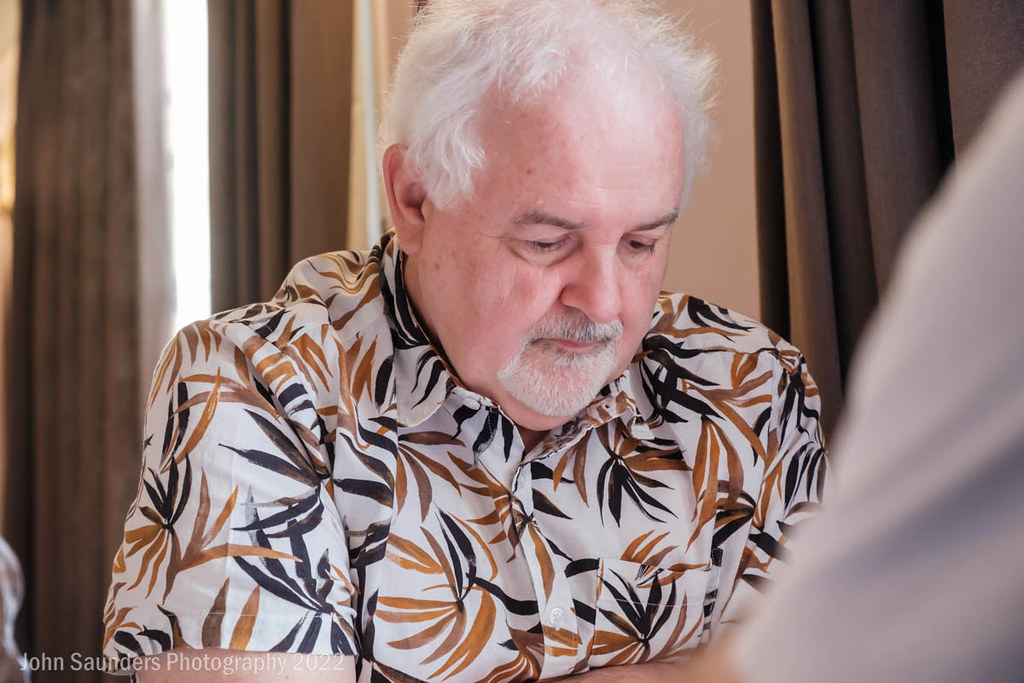
Kingston skipper David Rowson was especially pleased with the result because it showed a resilience in the team which has been growing all season. That resilience has been on full display over the past fortnight, when matches have come thick and fast at a time when we might have lowered our guard after securing the Surrey and Thames Valley league titles and when our resources have been stretched to the limit.
“It somehow seems a mark of a strong club to win by getting five draws and one win (as we also did against Hammersmith at home),” said David, “especially when we were missing several of our top players.” The first team’s unbeaten record this season – indeed since chess resumed after the pandemic! – survives, but this was a tough struggle and the pack are getting closer. The end of the league season can’t come soon enough. By now, captain, players and even the poor match summariser are exhausted.
Stephen Moss

